The ADATA XPG SX6000 Pro 1TB SSD Review: Realtek's Entry-level NVMe Solution
by Billy Tallis on December 18, 2019 12:30 PM ESTAnandTech Storage Bench - Heavy
Our Heavy storage benchmark is proportionally more write-heavy than The Destroyer, but much shorter overall. The total writes in the Heavy test aren't enough to fill the drive, so performance never drops down to steady state. This test is far more representative of a power user's day to day usage, and is heavily influenced by the drive's peak performance. The Heavy workload test details can be found here. This test is run twice, once on a freshly erased drive and once after filling the drive with sequential writes.
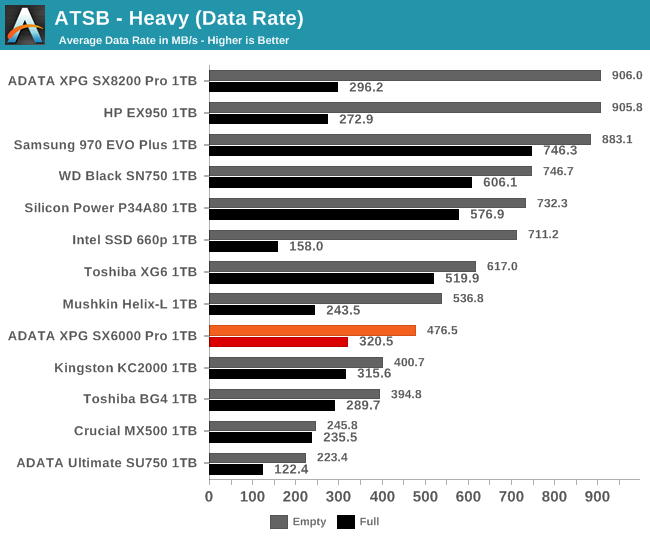
The ADATA SX6000 Pro has decent overall performance on the Heavy test for an entry-level NVMe SSD, and its full-drive performance is the best for this market segment. The Mushkin Helix-L and Intel 660p both use Silicon Motion controllers that offer better peak performance for the empty-drive test runs at the expense of worse full-drive performance (even the high-end SMI-based drives are a bit slower when full than the SX6000 Pro).
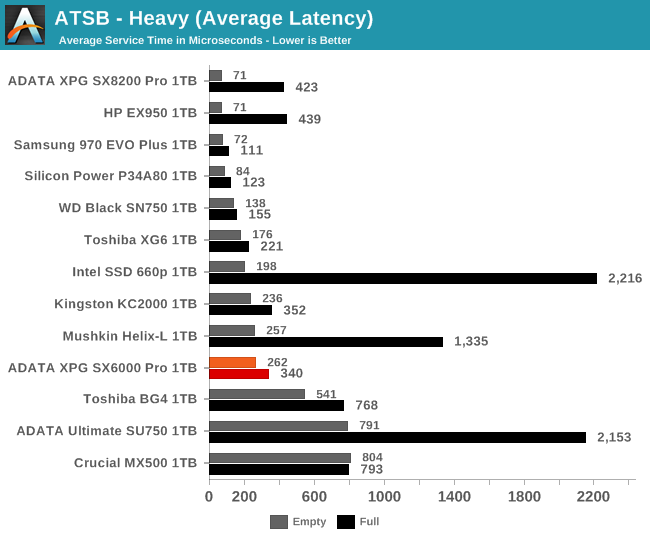
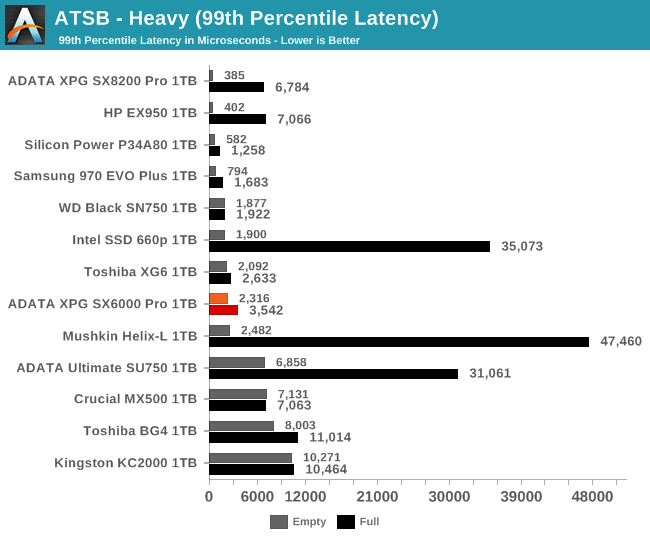
The average and 99th percentile latency scores for the SX6000 Pro are fine: all significantly faster than a mainstream SATA drive, with no huge latency spikes from running the test on a full drive.

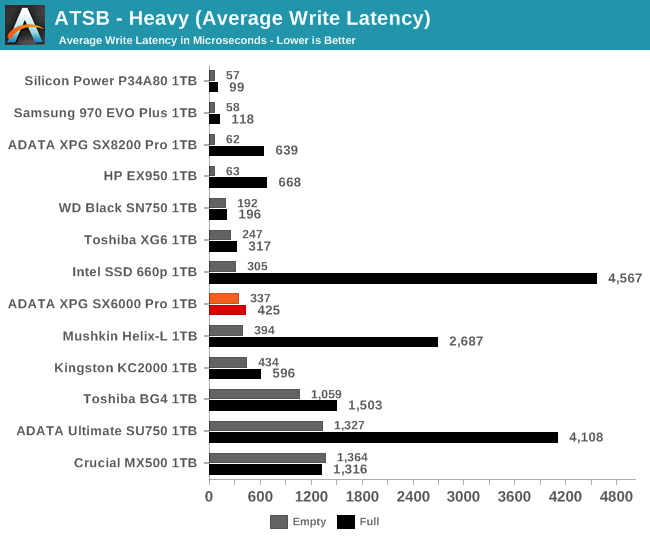
The average latencies from the SX6000 Pro are higher than most NVMe SSDs but still better than SATA. For writes, the SX6000 Pro gets close to some high-end NVMe drives.
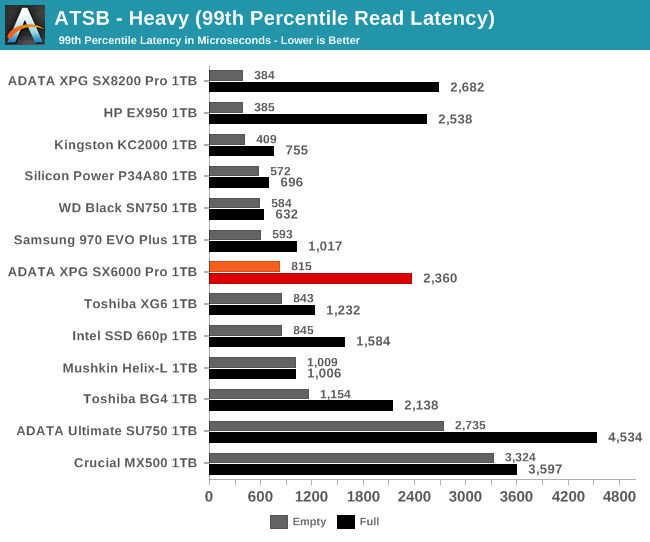
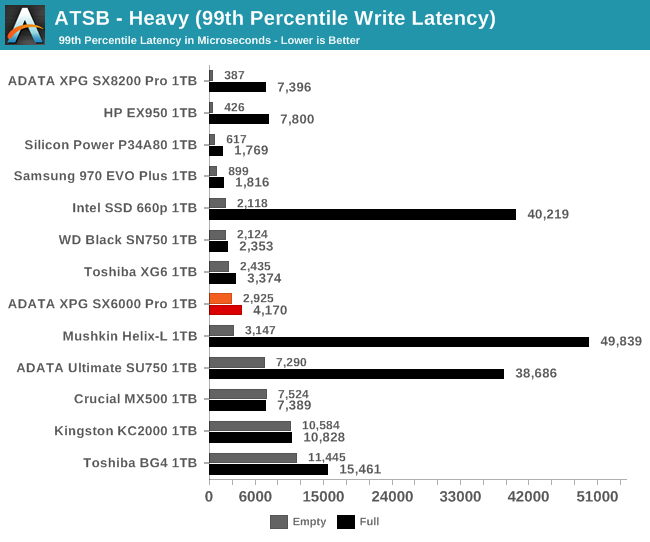
The 99th percentile read latency is the first sign that the SX6000 Pro has some difficulty with handling the Heavy test on a full drive, but the read QoS in that case is still better than the SATA drives. The 99th percentile write latencies are good whether the test is run on a full or empty drive.

The efficiency scores for the SX6000 Pro are in line with most high-end NVMe SSDs, but the other DRAMless NVMe drives again use half the energy to provide similar performance.










36 Comments
View All Comments
Samus - Wednesday, December 18, 2019 - link
I don’t think you are being critical enough of this drive. It is appallingly bad. It’s basically outclassed by SATA drives from years ago in almost every metric except sequential performance (where NVMe will naturally excel)But real world performance is terrible, power usage is high (and it has broken devsleep) and it isn’t very cheap. When you consider reliability is a total u known I’m struggling to imagine a single person who would consider this.
Billy Tallis - Wednesday, December 18, 2019 - link
Let me make it a bit clearer for you: https://www.anandtech.com/bench/product/2533?vs=22...The MX500 beats the SX6000 Pro on just ONE of those performance metrics. The picture's not that different if you compare against a Samsung SATA drive. Overall performance is clearly much better than a SATA SSD. It's not appallingly bad. It just isn't a high-end NVMe drive.
DPUser - Wednesday, December 18, 2019 - link
Appallingly Clearer. : )Alistair - Wednesday, December 18, 2019 - link
haha nice :)JoeyJoJo123 - Wednesday, December 18, 2019 - link
Based Billy Tallis *dabbing* on the n00bs in the comments section. FACTS don't care about your feelings, Samus. It's times like this I'm glad you can't edit your comments, since moments like these are eternalized forever.MFinn3333 - Wednesday, December 18, 2019 - link
To be fair, the Samsung 850 Pro does beat it in the sustained random read/writes, power efficiency of said read/writes and uses a lot less power while active idle.https://www.anandtech.com/bench/product/2310?vs=25...
(Blue is Samsung and Orange is ADATA because Samsung is blue in my mind).
To be fairer, the Samsung is at least five years old, costs three times as much if you can get it, and has an idle response that is 15X worse than the ADATA. The ADATA is clearly the better drive for 99% of the population.
The_Assimilator - Wednesday, December 18, 2019 - link
It's absolutely appallingly bad. You can't simply excuse broken power management with "the other vendors messed it up too", the point is that none of those other vendors have messed it up NOW. Realtek failed to learn from and avoid their competitors' mistake, and by doing so have introduced their controller with a handicap versus the same competitors. It's also both unproven, slower, and more expensive than older controllers that do have a known track record, so that's four strikes against the RTS5763DL.In contrast, drives using the two-year-old SM2263XT are faster, cheaper, and to be blunt, just better. There is thus no reason why anybody would ever choose a drive using RTS5763DL, and its complete failure to compete is only going to become more apparent once the next-gen SMI and Phison controllers arrive (and E12 products go EOL and get huge discounts).
In short, while not as bad as Realtek's attempt at a SATA SSD controller, the RTS5763DL is just a plain bad product that simply cannot be recommended in any way shape or form.
milli - Wednesday, December 18, 2019 - link
Well look at this one again then: https://images.anandtech.com/graphs/graph15139/sus...I've learned from real-life usage that this test is one of the most important metrics that you will notice in your day to day usage. The Realtek is by far the fastest cacheless NVMe controller out there in this test.
Also while the drive lacks DEVSLP, statements like "broken power management" are just false. The graphs clearly show that it cuts power in half in each state. Lacking DEVSLP does not equal broken power management. ADATA even clearly states this on their website.
gregassagraf - Wednesday, July 21, 2021 - link
well... I installed the xpg Gammix s41 which is based in the same microcontroller! I lost more than an hour of battery life in my laptop and now sleep mode is basically useless. One big mistake in my part was caring only about read and write speeds. I can't wait to replace this drive, its driving me mad!mark625 - Wednesday, December 18, 2019 - link
The HP EX950 1TB has been my favorite value/$ drive for a while, and it costs a whole $7 more than the SX6000 Pro. It whomps the XPG drive in almost every test, and in many tests it is more than twice as fast.In what possible scenario would the XPG drive be a smarter purchase than the HP? None that I can see. This review is way too forgiving.